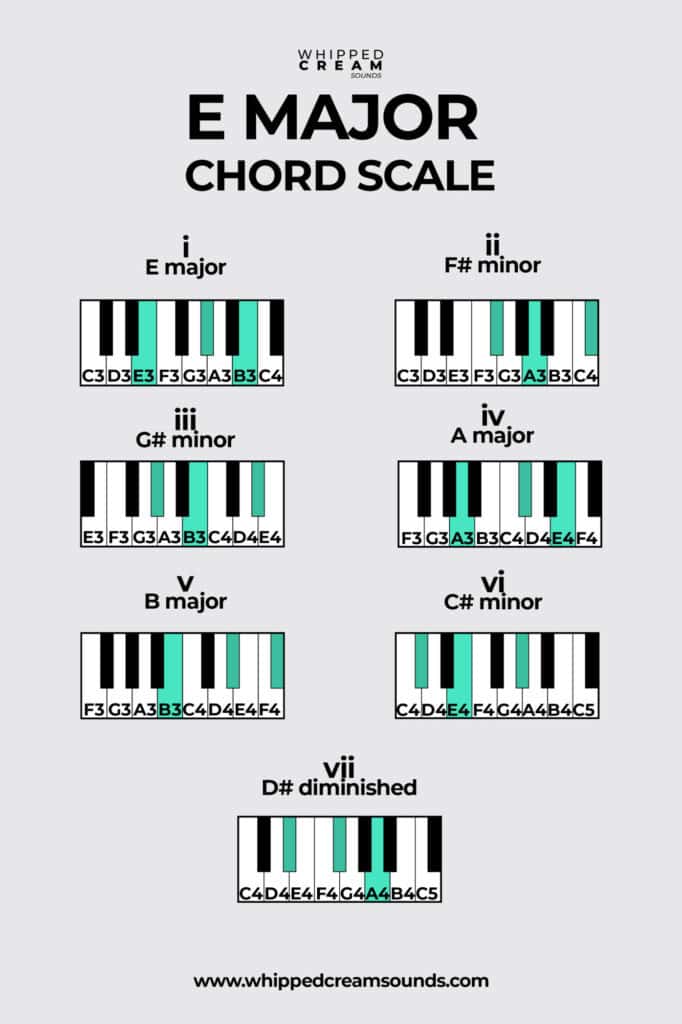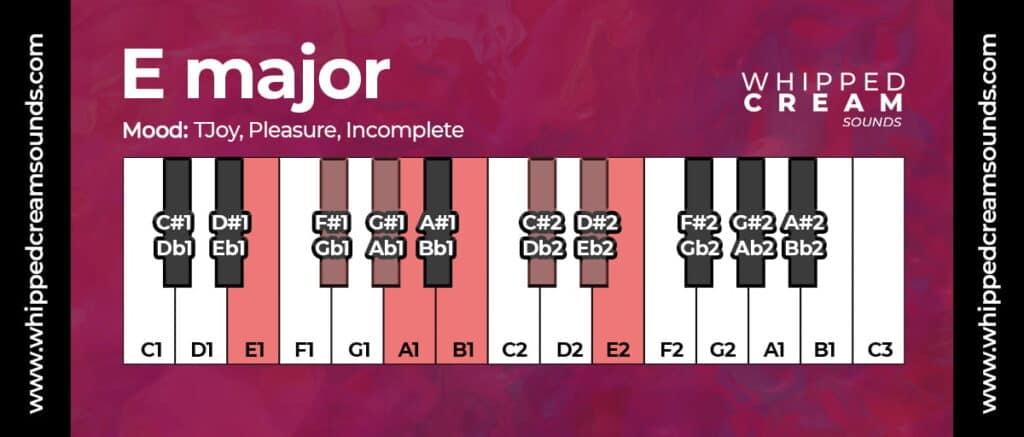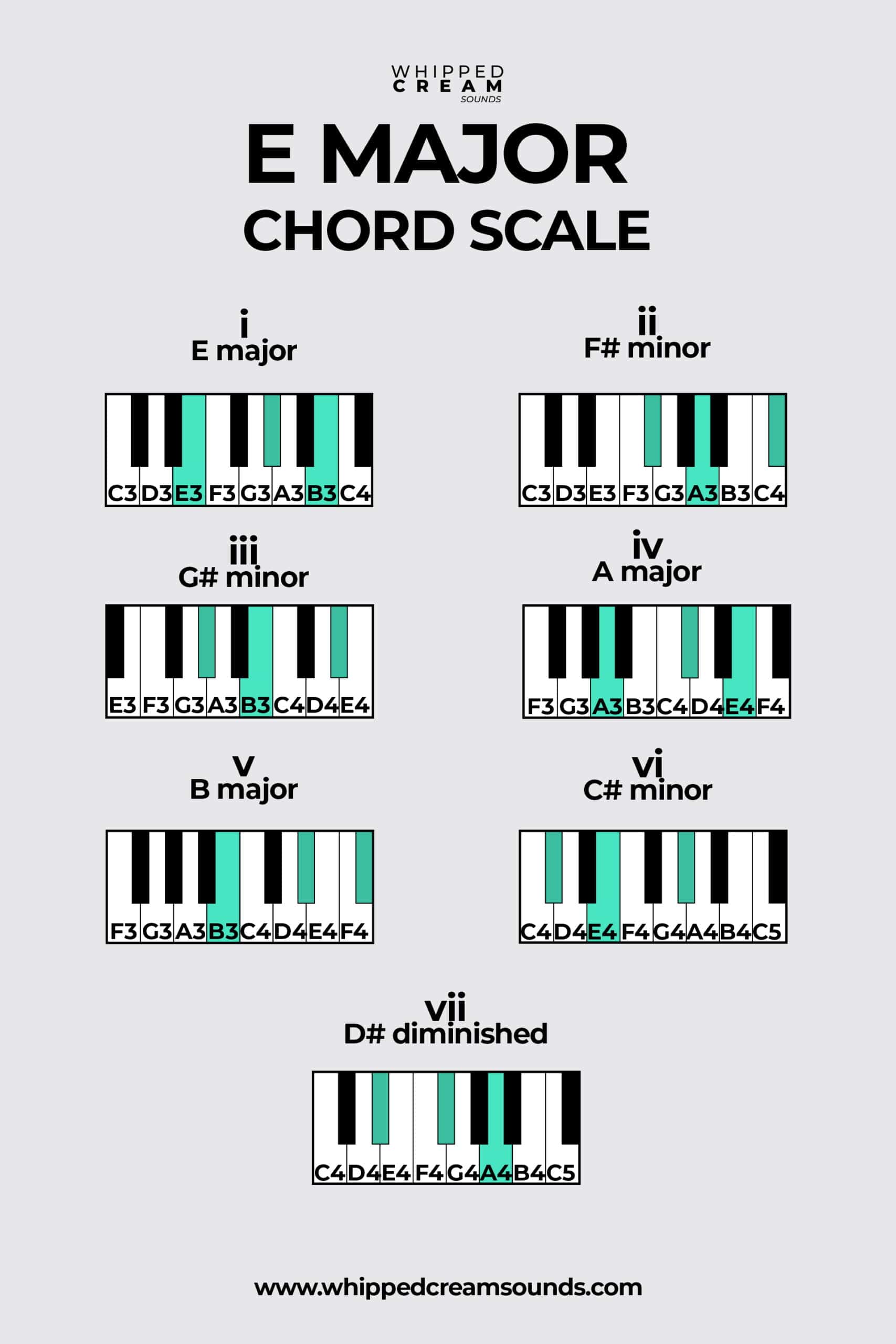The Eb major chord scale is a set of chords that are all in the E flat major key, and is a perfect scale to invoke emotions like cruelty & hardship. This post will go over the Eb major chord scale, how it differs from other scales, and why musicians need to know this information. The Eb major chord scale is also the same as the D# major chord scale. So, if you’re looking for that, you’re in the right place!
What Chords Are in The E Major Scale?

To find out the chords in the E major scale, you first need to find out what notes are in the E major scale.
Compose Seamless Chord Progressions
Learn to utilize voice leading and arpeggiation to create more polished and less amateur-sounding chord progressions. Train your ear, video-game style.

The E major scale consists of:
E, F#, G#, A, B, C#, D
Once you have the notes of the E major scale, you use something called a chord scale formula to work out which note is assigned to which chord value (major, minor, diminished & so on). Each of the above notes will have a chord assigned to it, and the way you work out what sequence of chords those are is by using the chord scale formulas (listed below).
The major & minor chord scale formulas are:
Major: major, minor, minor, major, major, minor, diminished
Minor: minor, diminished, major, minor, minor, major, major
Because the key you’re working in is major, you’ll want to use the major chord scale formula, which is: Major Minor Minor Major Major Minor Diminished. Using this chord scale formula, you plug it into the note from the E major scale.
Therefore, the Eb major chord scale consists of:
- E major
- F# minor
- G# minor
- A major
- B major
- C# minor
- D# diminished
If you don’t know how to play the natural triad shapes of these chords, you can use chord spellings to work them out by yourself. To do this, you always use the chord spelling formulas on the major key. So, if you wanted to find a minor chord, you’d use the major scale of the root note you want to build it from, using the major chord spelling to find the correct notes.
The most common chord spellings are:
- Major – 1, 3, 5
- Minor – 1, b3, 5
- Diminished – 1, b3, b5
- Augmented – 1, 3, #5
So let’s take the 3rd chord as an example. Seeing as it’s a G# minor chord, you’ll want to use the minor spelling (1, b3, 5) listed above, but use the G major scale. This is because we want to build a minor chord and the spellings are based on the major scale.
So, take the G major scale, count the 1 note (G#), then the 3 note and move it a semi-tone down (B), then the 5 note (D#).
Compose Seamless Chord Progressions
Learn to utilize voice leading and arpeggiation to create more polished and less amateur-sounding chord progressions. Train your ear, video-game style.

Chords In The Key of E major
All of the chords listed above are in the E major scale, and you can play these in any order to create chord progressions that sound great, in the key of E major. Some combinations will sound better than others, but this is all about trial and error.
You can use the chords above to make basic sounding progressions, but if you want to sound a bit more professional, you’ll want to start adding extensions, bass notes and inversions. We cover this extensively in our Piano Chord Poster PDF guide, which comes with every purchase of a poster.
What Notes Are in The Chords of The E Major Scale?
Now you know what the chords are in the E major scale, you need to know what notes make up each chord. In this section below we’ll list each chord and the notes, for you.
- E major – E, G#, B
- F# minor – F#, A, C#
- G# minor – G#, B, D#
- A major – A, C#, E
- B major – B, D#, F#
- C# minor – C#, E, G#
- D# diminished – D#, F#, A
Compose Seamless Chord Progressions
Learn to utilize voice leading and arpeggiation to create more polished and less amateur-sounding chord progressions. Train your ear, video-game style.

Common Chord Progressions in E Major
You can start to make chord melodies, with pre-made chord progressions, that already sound good, to help kickstart your ideas. To use these progressions in any scale, you need to replace the Roman numerals on the charts above, with the corresponding numbers on the chord scale sheet.
Anything with a 6, 7, 9 after it, is an extension chord, lowercase = minor, and uppercase = major.
Here’s the complete list of common chord progressions in E Major:
- I–V–vi–IV
- V–vi–IV–I
- vi–IV–I–V
- IV–I–V–vi


